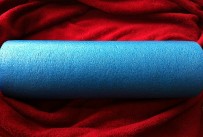Re-thinking foam rolling

Re-thinking foam rolling
Paul Kochoa, PT, DPT, OCS, CGFI
Two years ago, I wrote about how the foam roller is your friend. They’re ubiquitous at fitness centers, gyms, and physiotherapy clinics. I’ve advised my patients to use them as well. But I’ve come across some new information that may make you rethink the effectiveness of the foam roller.
Laying on a foam roller and moving your body definitely has its benefits. It’s supposed to loosen up your muscles and soft tissue. It can help you recover from your workout, improve your circulation a little, and release some trigger points.
Direct pressure over a tight muscle has shown to decrease its tone, meaning that pressing on a tight spot in a muscle causes certain neurological and vascular changes that inhibit that muscle from contracting. So that means that a tight muscle gets loose because it relaxes under the pressure.
Another theory is that foam rolling will break up adhesions in between tissue layers and fibers in the soft tissue. It doesn’t matter what that soft tissue is, (muscle, tendon, skin, or fascia) the foam roller can break up the stuck points. This will result in increased flexibility and range of motion. Many clinicians and studies agree that this is true, but the big question is “HOW”. That’s the area of controversy.
Does foam rolling change the structure of fascia? I don’t think so. Fascia is a really tough tissue, it’s supple, but tough, and the amount of force and load needed to deform it is pretty high.
Does foam rolling break up adhesions in tissue? This is a controversial question. The short answer is that more research is needed. But some believe that the mobility of tissue and increase of flexibility doesn’t come from breaking up adhesions. It may come from the aforementioned neurological changes. Another theory is that rolling moves water content around, and that decreases the tightness of tissue. Whatever the exact method, my two cents is that rolling may not be enough.
I believe that foam rolling really needs an oblique force component or “shear” to create increased mobility in tissue. Without this shear force, there really isn’t any component of the soft tissue mobilization that can increase the sliding component of the tissue. It’s the sliding component of all tissue that gives it its flexibility and range of motion.
So the next time you’re on a foam roller, try using some sliding force or active muscle movement to create the sliding force. This will make your rolling session much more effective, and you should feel looser afterwards.
If you would like more information, please call Professional Physical Therapy and Training at 973-270-7417. Our offices are located within the YMCA locations in Madison and Summit, NJ. You do not need to be a member of the YMCA to visit with us.
Image courtesy of Rachel Kramer Bussel / Flickr.com
